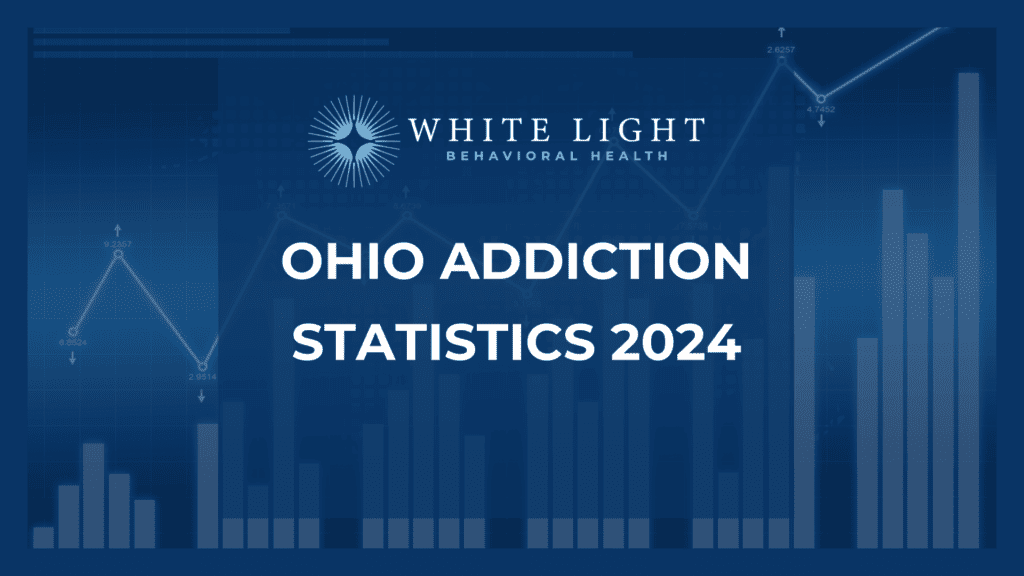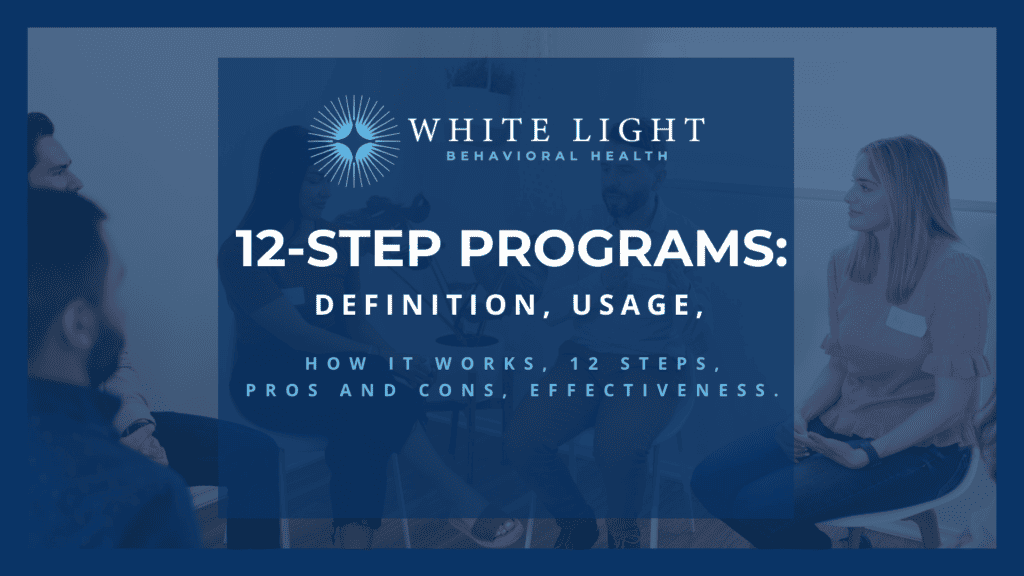Addiction to illicit street drugs, alcohol, and prescription medications remains a threat and menace across Ohio, ranking it as one of the top 5 US states struggling with substance abuse. Despite the government and community efforts to reduce addiction throughout the state, almost 700,000 Ohio residents ages 12 and above require drug rehabilitation services and treatment every year. This number excludes overprescription and medication misuse which is also an epidemic in the state.
Unfortunately, only a fraction of Ohioans with drug addiction problems actively participate in recovery programs. The most common causes for this resistance are feelings of overwhelm or pressure, distress, and isolation. In this article, we’ll dive into the Ohio addiction statistics including substance abuse, overdose rates, addiction rates in Ohio counties, and rehabilitation.
Key Takeaways
- There are over 1.2 million illicit drug users in Ohio, as of 2020.
- In 2023, up to 35.9 per 100,000 people in Ohio died as a result of drug abuse.
- 30% of individuals undergoing active substance abuse treatment admit to grappling with multiple drug addictions.
- Ohio teens are 4.2% less prone to drug use compared to the national average among American teenagers.
- Almost 20% of adults in Ohio 18 and older binge drink weekly.
- Teenagers in Ohio exhibit a 5.65% higher likelihood of alcohol consumption compared to the average American in their age group.
- In Ohio, males account for 54.8% of excessive alcohol use-related deaths.
- In 2023, Scioto County is ranked as the county with the most drug overdose cases in Ohio, topping a list of 20 counties with the highest rates.
- In the United States, Ohio is the 37th state with the most binge drinkers.
- Adderall is the “most frequently misused” prescription stimulant in Ohio, with about 2 million users.
- Ohio experienced a roughly 4% decline in the unintentional drug overdose rate in 2022.
- In 2024, outpatient mental health and substance abuse centers in Ohio are expected to generate revenue exceeding $1.4 billion.
Drug Abuse Statistics
Substance misuse reflects a concerning trend within the state of Ohio, especially for street drugs. The multifaceted and evolving drug use has disrupted communities and even youth across the state. Below are the illicit drug abuse and addiction statistics in Ohio.
- Around 1.2 million people in Ohio aged 12 or older use illicit drugs, including marijuana, cocaine, heroin, hallucinogens, inhalants, or methamphetamine.
Substance Use by Age Group in Ohio, Average Estimated Numbers, in Thousands, 2022
| 12+ | 12-17 | 18-25 | 26+ | 18+ | |
| Past Month Illicit Drug Use | 1,253 | 60 | 289 | 904 | 1,193 |
| Past Year Marijuana Use | 1,704 | 95 | 424 | 1,185 | 1,609 |
| Past Year Cocaine Use | 187 | 2 | 55 | 130 | 185 |
| Past Year Heroin Use | – | – | 2 | 27 | 29 |
| Past Year Methamphetamine Use | 71 | 1 | 7 | 63 | 70 |
| Past Year Prescription Pain Reliever Misuse | 359 | 17 | 55 | 287 | 342 |
- Over 300,000 use illicit drugs other than marijuana.
- Nearly 6% of people aged 12 or older experienced past-year Illicit Drug Use Disorder IDUD) in 2020.
- Up to 35.9 per 100,000 people died in Ohio due to drug abuse in 2023.

- The national average for past-month use of illicit drugs in Ohio is 8.82%.
- Three out of 10 people under active substance abuse treatment admit to having multiple drug addictions, worsening their effects.
- Ohio teenagers are 4.19% less likely to have used drugs compared to the average American teenager.
- 71,000 or 7.98% of Ohio teens between ages 12 and 17 years, used drugs in 2023.
- Among them, 80.28% reported using marijuana in 2023.
- Nearly 12% of all Ohio teens between ages 12 and 17 years reported using marijuana in 2022, while 0.34% reported using cocaine.
- 430,000 adults between ages 18 and 25 in Ohio used drugs in 2023.
- Ohio residents between ages 18 and 25 years are 1.28% more likely to use drugs than the average American in the same age group in 2023.
- 3.48% of teens between ages 12 and 17 years met the criteria for Illicit Drug Use Disorder (IDUD) in the last year of 2023.
Alcohol Abuse Statistics
The Ohio Department of Mental Health & Addiction Services defines binge drinking as the consumption of four or more alcoholic drinks in women and five or more for men on one occasion, with 5.7 as a median number. This provides parameters to help address and respond to instances of harmful alcohol consumption effectively.
- 19.5% of Ohioan adults reported weekly binge drinking.

- Ohio ranks 37th for excessive alcohol use in the United States.
- More than 2 million residents in Ohio 12 years or older binge drink in 2020.
- Over 80,000 Ohioans are underage drinkers, 12 to 17 years old.
- Around 10% of Ohio residents aged 12 or older experienced Alcohol Use Disorder (AUD) in 2020.
- Nearly 20% of adults in Ohio 18 and over are binge drinkers, indicating a rising trend in alcohol abuse.

- Almost 10% of Ohio teens drink alcohol in 2023.
- Teens in Ohio are 5.65% more likely to use alcohol than the average American in their age group.
- 1.57% of all 12- to 17-year-olds met the criteria for Alcohol Use Disorder (AUD) in the last year of 2023.
- 25% of active drinkers consume a median of 8.2 drinks per binge.

- Excessive alcohol use in Ohio accounts for an average of 5,739 annual deaths.
- For every 2,056 Ohioan adults aged 18 and older, there is one death due to excessive alcohol use, which amounts to about 6.24 deaths per 10,000 adults.
- 54.8% of excessive alcohol use deaths in Ohio are male.
- 83% of deaths related to excessive alcohol use in Ohio are individuals aged 35 years and older.
Prescription Medications Abuse
Overprescription is a public health concern in Ohio and the leading cause of drug injuries and deaths. This illegal practice contributes to the drug crisis statewide and facilitates its unlawful distribution. Below are the key statistics for prescription medication misuse in Ohio.
- There are 47.9 opioid prescriptions for every 100 people in Ohio, exceeding the national average of 39.5 prescriptions. This is merely one contributing factor to the huge surge of opioid prescription abuse and disorders among its residents since 1999-2022.

- Opioid addiction in Ohio affects twice the national average, encompassing 1.4% of the state’s population.
- In Ohio, 6.8% of college students admitted to misusing pain medications, 7.8% confessed to misusing sedatives, and 14.5% acknowledged misusing stimulants.

- 11.4% of Ohioan college students who misuse prescription drugs find it “somewhat easy” or “very easy” to obtain pain medication for non-medical use.

- Around 3 million Ohio residents actively use stimulants such as Adderall every year, reported as one of the “most frequently misused” prescription stimulants.
- 13.6% of Ohio’s Medicaid population had Opioid Use Disorder OUD.
- Men exhibited a higher prevalence of Opioid Use Disorder (OUD) at 16.7% compared to women at 11.4%.
Drug Overdose and Death Rates
Fatalities from drug overdose continue to cast a shadow over communities nationwide, with Ohio being no exception. Rampant substance misuse poses a grave public health risk and serves as a primary driver behind the escalating rates of drug-related injuries and fatalities in the state. Delving into the depths of this crisis, let’s explore the statistics surrounding drug overdose and death rates in Ohio.
| 2016 | 2017 | 2018 | 2019 | 2,020 | 2021 | ||
| Age | |||||||
| <15 | 4 | 5 | 4 | 4 | 5 | 7 | |
| 15-24 | 345 | 361 | 247 | 241 | 327 | 260 | |
| 25-34 | 1,143 | 1,330 | 1,063 | 1,072 | 1,325 | 1,230 | |
| 35-44 | 1,022 | 1,283 | 1,054 | 1,108 | 1,385 | 1,492 | |
| 45-54 | 886 | 1,051 | 703 | 807 | 1,046 | 1,118 | |
| 55-64 | 557 | 700 | 571 | 643 | 740 | 854 | |
| 65+ | 93 | 124 | 122 | 153 | 189 | 213 | |
| Sex | |||||||
| Female | 1,284 | 1,560 | 1,250 | 1,269 | 1,599 | 1,572 | |
| Male | 2,766 | 3,294 | 2,514 | 2,758 | 3,418 | 3,602 | |
| Race/Ethnicity | |||||||
| American Indian, Non-Hispanic | 4 | 16 | 6 | 4 | 6 | 5 | |
| Asian/Pacific Islander, Non-Hispanic | 8 | 14 | 11 | 14 | 21 | 23 | |
| Black, Non-Hispanic | 426 | 611 | 512 | 650 | 841 | 969 | |
| White, Non-Hispanic | 3,538 | 4,109 | 3,131 | 3,247 | 3,992 | 4,018 | |
| Hispanic | 69 | 98 | 93 | 102 | 144 | 147 | |
| Race/Ethnicity and Sex | |||||||
| Black Non-Hispanic Females | 126 | 162 | 155 | 187 | 250 | 273 | |
| Black Non-Hispanic Males | 300 | 449 | 357 | 463 | 591 | 696 | |
| White Non-Hispanic Females | 1,127 | 1,365 | 1,069 | 1,055 | 1,314 | 1,261 | |
| White Non-Hispanic Males | 2,411 | 2,744 | 2,062 | 2,191 | 2,678 | 2,757 | |
| Hispanic Females | 22 | 22 | 20 | 17 | 28 | 27 | |
| Hispanic Males | 47 | 76 | 73 | 85 | 116 | 120 | |
| Total Unintentional Drug Overdose Deaths | 4,050 | 4,854 | 3,764 | 4,028 | 5,017 | 5,174 | |
- Unintentional drug overdose rate in Ohio declined by about 4% in 2022.
- The highest number of overdose deaths ever recorded in Ohio was in 2020, with over 500 fatalities per month.
- Fentanyl-related misuse in Ohio caused an overall number of more than 2,000 unintentional drug overdose deaths in 2022.
- In 2022, there were approximately 280 unintentional drug overdose deaths in Ohio due to cocaine use.
- In 2021, the number of unintentional drug overdose deaths rose by 3% compared to 2020, reaching a total of 5,174 fatalities.
- From 2020 to 2021, the number of related deaths decreased by 48% for heroin and 6% for natural and semi-synthetic opioids.
- Fentanyl was implicated in 80% of Ohio’s unintentional drug overdose deaths in 2021, marking a slight decline compared to the statistics of 2020 (81%).
- In 2021, cocaine accounted for 29% of unintentional drug overdose deaths, up from 25% in 2020.
- Opioids were involved in over 75% of drug overdose deaths in 2021, including prescription opioids, heroin, and synthetic opioids.
- Ohio had 48.1 drug overdose deaths per 100,000 people.
Addiction Rates Across Regions
Understanding the prevalence of addiction across different regions is crucial in comprehending the diverse dynamics of substance abuse within communities. From urban to rural areas, addiction rates vary, reflecting unique socio-economic, cultural, and environmental factors. Let’s explore the addiction rates across various Ohio counties, including fatality rates from drug abuse.
- 20 Ohio counties have the highest unintentional drug overdose rates in 2023, with Scioto County ranking first (106.2 fatalities per 100,000 people).
- Gallia County, Ohio, ranked second for the highest unintentional drug overdose rate with 76 fatalities per 100,000 people.
- Lawrence County, Ohio, ranked third, with 68.8 unintentional drug overdose deaths per 100,000 people.
- 293 drug overdose deaths in Montgomery were recorded in 2023 and 316 in 2022, reflecting a 7.3% decrease over a two-year period.
- Clark County had 79 drug-related deaths in 2021, indicating a significant increase of 51.9% from the 52 deaths in 2020.
- The monthly average for fatal overdoses in Clark County in 2021 was approximately 14.
- Warren County, Ohio, saw a 142% increase in methamphetamine seizures and an 88% decrease in heroin and fentanyl seizures in 2018.
Drug Addiction Rehab and Treatment Services
The complexities of drug addiction and seeking effective treatment services is a journey fraught with challenges and opportunities for those affected. The good news is that Ohio provides proper access to quality rehabilitation and treatment services to support individuals struggling with addiction.
- Outpatient mental health and substance abuse centers in Ohio will generate more than $1.4 billion in revenue in 2024.
- Psychiatric and substance abuse hospitals in Ohio are projected to generate approximately $598.4 million in revenue this year 2024.
- By 2024, Ohio’s residential mental health and substance abuse facilities will generate approximately $510.4 million in revenue.
- There are over 580 active substance abuse clinics in Ohio.
- Ohio drug rehabs service more than 66,200 patients every year.
- Over 3,600 patients sign up for Ohio’s drug residential or non-hospital services.
- More than 500 people receive drug rehabilitation treatment in Ohio’s hospitals.
- 5 drug rehab facilities in Ohio are free.
- Ohio’s outpatient services receive 4.88% of the total expenditure, amounting to $112.7 million from the U.S. public.
Ohio continues to struggle with addiction, a persistent issue that deeply affects public health and well-being. Despite the concerted efforts to overcome it, substance abuse remains prevalent, with numbers catching up to a million. This stark reality underscores the pressing need for comprehensive strategies that tackle the underlying causes of addiction, improve access to treatment and rehabilitation services, and enhance prevention efforts throughout the state.
By keeping up with the current state and addiction rates of any type in Ohio, we can shed light on the multifaceted nature of addiction. These findings highlight the importance of targeted interventions that address the unique needs of different age groups and regions within the state. A collaborative approach to reducing the stigma surrounding addiction can help Ohioans move closer to creating healthier communities and fostering resilience among its residents.
What city in Ohio has the highest overdose rate?
Ohio’s long-term overdose death capital is Portsmouth, with an average of 55 people treated every month.
What is the fastest-growing drug problem in Ohio?
Prescription abuse is the nation’s fastest-growing drug abuse, including Ohio, with opioid misuse affecting twice the national average.
What is the estimated cost of substance abuse each year in Ohio?
The state spends two cents of every dollar towards awareness programs addressing drug abuse in Ohio and approximately 90 cents of every dollar for damages.
What is the “drunkest” county in Ohio?
21.7% of adults in Mercer County drink excessively, ranking them 247th out of 3,142 counties nationwide with heavy drinkers.
How much does it cost a person on average for an outpatient rehab in Ohio?
On average, individuals undergoing outpatient rehabilitation in Ohio can expect to pay around $1,705 per patient.
How much does it cost a person on average for residential treatment in Ohio?
In Ohio, $207 million, or about 4% of the total U.S. public spending, goes towards residential treatment.
What is the average overdose death rate in Ohio?
Ohio has 4,251 overdose deaths annually.
Sources:
- Substance Abuse and Mental Health Services Administration
- National Center for Drug Abuse Statistics
- Centers for Disease Control and Prevention
- America’s Health Rankings
- Ohio Department of Mental Health & Addiction Services
- National Insitute on Drug Abuse
- Campus Drug Prevention
- Ohio PDMP Interactive Data Tool
- PubMed
- Ohio Preliminary Data Overdose Deaths 2023
- Montgomery County COAT
- Clark County Health District
- Warren County Ohio
- Statista

Share This Post



